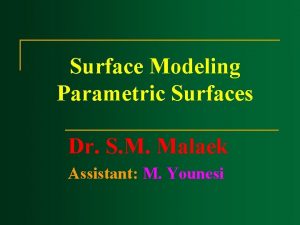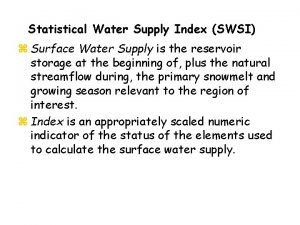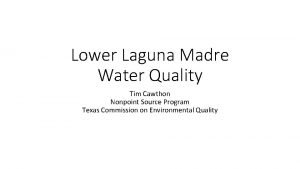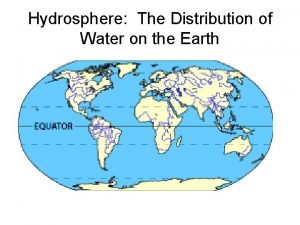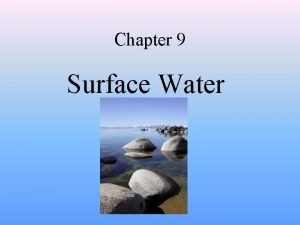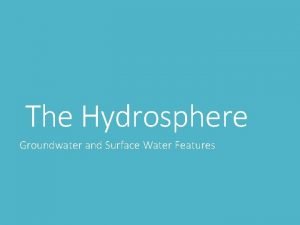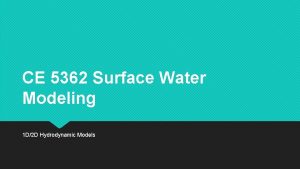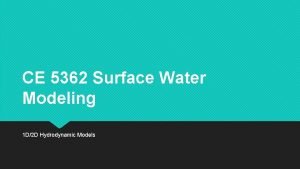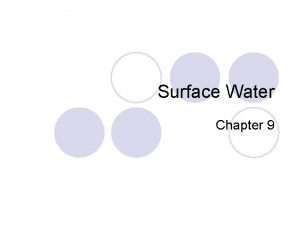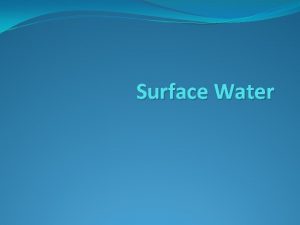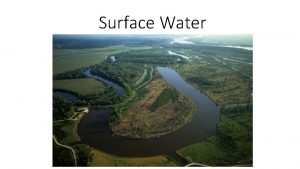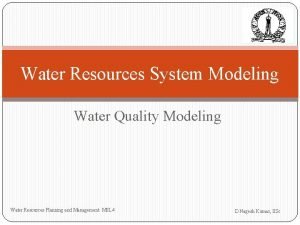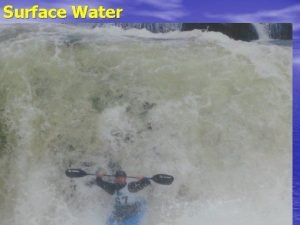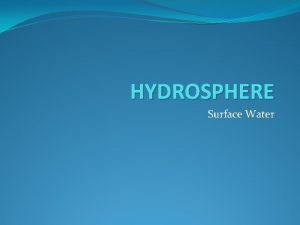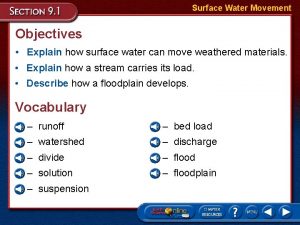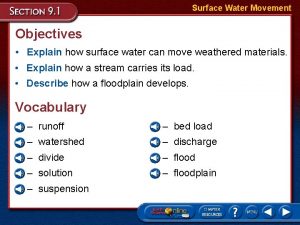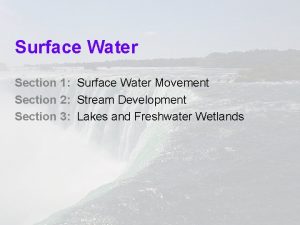CE 5362 Surface Water Modeling 1 D2 D














- Slides: 14

CE 5362 Surface Water Modeling 1 D/2 D Hydrodynamic Models

Modeling Philosophy Modeling What is a model? Why model? Parsimony Modeling Protocol Weekly Zoom meeting

Modeling Computational hydraulics aims to provide the engineer with guidance for correct design, construction, and operation of hydraulic works, including closed conduit, open conduit, and porous flow systems. The computational procedures are reasonably complex and typically beyond the limits of hand computation; computer programs are necessary and required for many computational hydraulics problems. Modeling is the art of representing reality in a simplified form, sufficient to answer questions about that reality

What is a Model? There are many definitions, a few are: 1. A model is a simplification of reality that duplicates the excitation-response of the real system but is faster, smaller, or more practical to study than the real system. 2. A mathematical model is composed of mathematical expressions quantifying fundamental physical principles (force, energy, mass, etc. ). These expressions are adapted and simplified in each case to the special features of the problem to be tackled. 3. A model is any device that represents an approximation of a field situation.

What is a Model? There are several categories of models Physical models such as laboratory sand tanks, flumes, pipe networks, porous columns, batch reactors, and pilot plants are used to directly simulate various conditions anticipated in full scale settings. Physical models tend to be the most costly to build from scratch, but many questions cannot be answered without these kind of model Analog models such as electric circuit analogs or Hele-Shaw analogs are used to indirectly simulate field conditions by direct simulation in a domain analogous to the real setting. Analog computers are quite rare today, but in the 1960's were a principal tool in modeling and were used in aerospace as well as mundane civil engineering applications. A laboratory mouse used to test medicine doses (usually for lethality) is an example of an analog model for human testing. Mathematical models indirectly simulate field conditions by solution of a governing equation thought to represent the system, along with auxiliary equations that describe the boundary and forcing conditions. These physics and chemical relationships are represented as sets of algebraic equations. Conversion from physics to the computer is via finite-difference, finite-element, finite-volume analysis. Particle tracking is an alternate approach. Mathematical models are solved analytically or numerically -- both solutions may require a computer.

What is a Model? The set of commands used to solve a mathematical problem on a computer is the program or code. The code is generic, whereas a model is comprised of boundary and initial conditions, a computational grid, material properties on that grid, and forcing terms. Thus a model is both the data and code, while the program is just a tool. Another kind of model is a statistical model that relates observations to excitations without necessarily attempting to relate underlying physics of the problem (Machine Learning; Neural Networks, Regression Trees, Support Vector Machines are these kind of models). All the kinds of models are useful and appropriate tools in their various applications.

Why Model? There are several good reasons to model, and many poor reasons. Most modeling efforts are attempts to predict the consequences of a proposed design or operation strategy. Models can also be used to interpret system dynamics or as a framework for organizing data. Models can also be used to study processes in generic settings. Generic models are useful in formulating regulatory guidelines and as screening tools to identify suitable or unsuitable designs. These three modeling applications are fundamentally different -- even though they use the same toolkits. Table 1 lists these three application types along with some opinions as to the need to calibrate.

Why Model?

Why Model? Models should be investigated and used only if they can answer questions that need to be answered. A list of questions should be prepared prior to beginning a modeling exercise, there are likely some situations where a model may not even be needed. Models should not be performed to “prove" anything -- a computer model cannot prove anything.

Why Model? Models should be investigated and used only if they can answer questions that need to be answered. A list of questions should be prepared prior to beginning a modeling exercise, there are likely some situations where a model may not even be needed. Models should not be performed to “prove" anything -- a computer model cannot prove anything. Models can be used to identify poor solutions to a problem, but rarely can they identify good solutions. Models can be used to evaluate alternative designs (and perhaps this task is a good use of a model). Models can occasionally be used to infer natural relationships that would otherwise go unnoticed.

Principle of Parsimony The principle of parsimony is fundamental in engineering modeling. A model should only be as complex as necessary to answer the questions asked of it. All other things being equal a simpler model (fewer parameters) is superior to a complicated model. This principle is sometimes referred to as Occam's razor.

A Modeling Protocol 1. List the questions that need to be answered -- this step is crucial, it is the problem statement. 2. List the available and necessary data to answer the questions. If the data do not exist, that fact should also be noted. 3. Assuming a model is the best tool, list the physical principles that need to be preserved in a model. 4. Develop and test an algorithm to simulate the physical principles. In many cases, a professional program will be the tool of choice, although sometimes a “roll-your-own” approach makes better sense. Prior to actually solving the problem in question, develop and test simple problems to which you know the answer. This exercise develops the modelers skill and builds confidence in the tool.

A Modeling Protocol 5. Apply the model working from a simple, known solution towards the problem to which you seek the actual solution. This step requires keeping a “simulation log. " In this log, file names should be recorded (input files should change name each new run -- record in the log the general nature of each simulation, the output, and the modelers interpretation for each new run) 6. When the real problem is run construct professional exhibits (graphs, tables, etc. ) for inclusion in the modeling report. Pages of output may be meaningful, but are not sufficient for a professional document. 7. Build the modeling report, including the methods used, inputs and assumptions, outputs (results) and their interpretation in the context of the original problem.

Recommended Reading Anderson, M. P. and W. W. Woessner (1992). Applied Groundwater Modeling. San Diego: Academic Press. (pp 2 -10) Bear, J. (1972). Dynamics of Fluids in Porous Media. New York: Dover Publications, Inc. (Chapter 11)
 Water and water and water water
Water and water and water water Modeling role modeling theory
Modeling role modeling theory Relational vs dimensional data modeling
Relational vs dimensional data modeling Surface modelling in cad
Surface modelling in cad How do u find lateral surface area
How do u find lateral surface area High surface tension vs low surface tension
High surface tension vs low surface tension Surface area of a cone
Surface area of a cone Surface water supply index
Surface water supply index Njdep surface water quality standards
Njdep surface water quality standards Tceq
Tceq Images of hydrosphere
Images of hydrosphere Water flowing downslope along earth's surface
Water flowing downslope along earth's surface Texas surface water quality standards
Texas surface water quality standards Chapter 9 surface water chapter assessment answer key
Chapter 9 surface water chapter assessment answer key Hydrosphere
Hydrosphere



